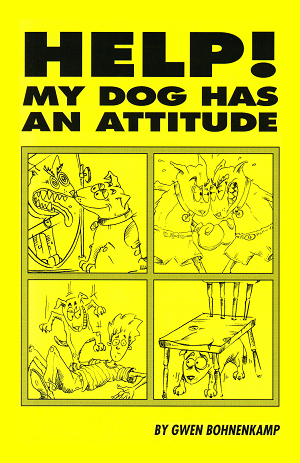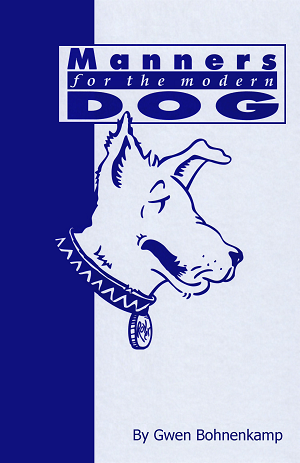Obedience Training a Dog or Puppy

Obedience Training is one of the best things you can do for your dog or puppy... and yourself.
Obedience training doesn't solve all behavior problems, but it is the foundation for solving just about any problem. Training opens up a line of communication between you and your dog. Effective communication is necessary to instruct your dog about what you want her to do. You can teach her anything from 'stay' (don't bolt out the door) to 'sit' (don't jump up on the visitors) to 'off' (don't chew the furniture).
Dogs are social animals and without proper training, they will behave like animals. They will soil your house, destroy your belongings, bark excessively, dig holes in your yard, fight other dogs and even bite you. Nearly all behavior problems are perfectly normal canine activities that occur at the wrong time or place or are directed at the wrong thing. For example, the dog will eliminate on the carpet instead of outside; the dog will bark all night long instead of just when a stranger is prowling around outside; or the dog will chew furniture instead of his own toys. The key to preventing or treating behavior problems is learning to teach the dog to redirect his natural behavior to outlets that are acceptable in the domestic setting.
Obedience training is also an easy way to establish the social hierarchy. When your dog obeys a simple request of 'come here, sit,' she is showing compliance and respect for you. It is NOT necessary to establish yourself as top dog or leader of the pack by using extreme measures such as the so-called alpha rollover. You CAN teach your dog her subordinate role by teaching her to show submission to you in a paw raise (shake hands), roll over or hand lick (give a kiss). Most dogs love performing these tricks (obedience commands) for you which also pleasantly acknowledge that you are in charge.
Obedience training should be fun and rewarding for you and your dog. It can enrich your relationship and make living together more enjoyable. A well-trained dog is more confident and can more safely be allowed a greater amount of freedom than an untrained one. A trained dog will come when called.
Some people debate whether or not it is possible to train puppies, and others ask whether it is possible to teach an old dog new tricks. The answer to both questions is an unequivocal YES. Whatever the age of your dog, the right time to begin training is right now! The most important time in your dog's life is right now. Your dog's behavior is constantly changing. A dog that is well-behaved today will not necessarily remain that way forever. New problems can always develop. Existing problems can always get worse.
Enroll in a local dog obedience training class to learn the basics. Then most teaching and training can and should be done in your home. It is best to begin training in an area that is familiar to your dog and with the least amount of distractions as possible. When you feel both you and your dog are skilled at several obedience commands, then take these commands to different areas. Introducing distractions may seem like starting all over again, but it's worth the effort. In reality, who cares if your dog will sit stay when no one is around? What you need is a dog who will sit-stay when company is at the door. Who cares if your dog heels beautifully in your own back yard? But you need to start there if you eventually want a dog who will heel beautifully when walking down Union Street.
If you want your dog to be obedient in your car, guess where you have to practice? If you suddenly want your dog to down-stay while you are trying to move over 3 lanes to make an exit, you had better find time to practice those obedience commands in the car long before you need them. Don't drive and practice at the same time. Practice while the car is parked or while someone else is driving.
Keep the obedience training sessions short and sweet. It is dull and boring to schedule tedious and lengthy training sessions. Instead, integrate training into your daily routine. Make obedience training interesting and meaningful to your dog. If Puppy insists on following you from room to room while you are getting ready for the day, then insist he have something to do too.
"Heel" from the bedroom to the bathroom. "Down-stay" while you're brushing your teeth. "Heel" from the bathroom to the kitchen. "Sit-stay" while grinding the coffee beans. "Go find the ball" while you get dressed. Now "go get the leash" so you can go for a walk. "Sit" when the door is opened, "sit" again when the door is closed. And so on. Be sure that obedience training infiltrates your dog's favorite activities and that your dog's favorite activities infiltrates training. Your dog's favorite activities should become training, so that training becomes the dog's favorite activity.
Rewards While Training
The single most important aspect of training is rewarding your dog for good behavior. The more times the dog is rewarded, the quicker he will learn. Therefore, it's essential that you set up situations repeatedly in order for your dog to get plenty of practice at doing the right thing. It's equally as important that you always praise your dog for good behavior instead of taking it for granted. It's easy to forget to praise good behavior because it goes unnoticed. But the very nature of misbehavior gets our attention. We don't notice when our dog is lying quietly, but excessive barking gets our attention. How many of us take notice and praise our dogs when they chew their own toys? But we all go berserk when we notice our favorite pair of shoes chewed up! Praise and reward are the most important part of maintaining good behavior and preventing problems from arising.
Reprimands While Training
Some dogs feel they are constantly bombarded with, 'NO, Stop that, get off, Bad dog!' They tend to get used to it and so the reprimands become meaningless and are ignored. If most of our interaction with the dog is praise for good behavior, then reprimands will take on much more meaning. Whenever you find the need to reprimand your dog, immediately show him what you want him to do, then reward him for getting it right. If you catch him chewing the furniture, tell him, 'Off!' Then immediately direct him to his own toys, enthusiastically entice him to chew on them and praise him for doing so.
If done correctly, your voice alone is sufficient for reprimand. A correct reprimand is short, sharp and immediate. Don't continue to nag the dog and never reprimand him unless you catch him in the act. Never hit, kick, slap or spank your dog. This type of inappropriate punishment always creates more problems and usually makes existing problems worse. Not only will you have a barking, chewing dog, but one that is leery, hand-shy, fearful or aggressive.
Obedience Training a Dog or Puppy
Recommend this webpage... share with friends !These articles may also be of interest...
^ Top of Page


